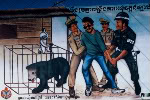The Critically Endangered Siamese crocodile, once believed to be extinct in the wild, received some uplifting news this week. DNA testing of 69 rescued crocodiles at Phnom Tama Wildlife Rescue Center (PTWRC) in Cambodia found 35 purebred Siamese crocodiles.
“This could provide a critical lifeline for the long-term preservation of this critically endangered species,” said Mr. Nhek Ratanapech, Director of PTWRC.
Researchers with Fauna and Flora International (FFI), the Cambodia Forestry Administration, and Wildlife Alliance collected blood and tissue samples from crocodiles at the rescue center in February. They found six adult Siamese crocodiles, which could be important breeding animals, and twenty younger animals that may be able to be returned to the wild.
 Siamese crocodile. Photo by: Rhett A. Butler. |
The organizations hope to begin captive breeding in early 2010. Offspring would be raised for two years and then released into the wild to bolster current populations.
In 1992 Siamese crocodiles were declared “effectively extinct in the wild” by the IUCN. Once widespread throughout Southeast Asia, the species suffered decades of poaching and habitat loss until it vanished. However, eight years later, FFI and the Cambodian Forestry Administration rediscovered a population of the crocodiles during a joint expedition within Cambodia’s Cardamom Mountains. Together they initiated the Cambodian Crocodile Conservation Program (CCCP).
Although protected by law in Cambodia, wild Siamese crocodiles are still captured and sold to crocodile farms. In addition, planned dam developments in rivers and habitat loss still threaten the species. Little is known about this species’ behavior in the wild.
The DNA analysis was made possible with funds from the Disney Worldwide Conservation Fund.
Related articles
War and conservation in Cambodia

(06/21/2009) The decades-long conflict in Cambodia devastated not only the human population of the Southeast Asian country but its biodiversity as well. The conflict led to widespread declines of species in the once wildlife-rich nation while steering traditional society towards unsustainable hunting practices, resulting in a situation where wildlife is still in decline in Cambodia, according to a new study from researchers with the World Wildlife Fund (WWF).
Rare softshell turtle rediscovered in Cambodia
(05/16/2007) Scientists from conservation International have successfully hatched a clutch of eggs from one of the world’s most endangered turtle species.
US ranks #7 in global forest loss, Cambodia has worst deforestation rate
(11/16/2005) Cambodia has the world’s highest deforestation rate, Brazil loses the largest area of forest annually, and Congo consumes more bushmeat than any other tropical country. These are among the findings from mongabay.com’s analysis of new deforestation figures from the United Nations.